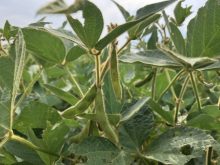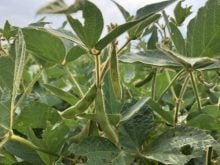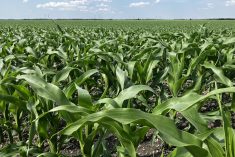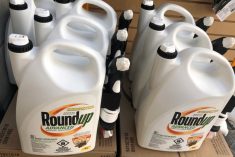Glacier FarmMedia — An Arizona court decision that essentially prohibits American farmers from using dicamba for over-the-top spraying on soybeans and cotton will not stop Canadian growers from using the herbicide this year, says Bayer Crop Science Canada.
Earlier this week, a federal court judge “vacated” the U.S. registrations of several dicamba-based herbicides, saying the Environmental Protection Agency “violated procedures mandating public input,” Reuters reported.
The ruling affects Bayer’s XtendiMax, BASF’s Engenia and Sygnenta’s Tavium. The herbicides are applied during the growing season to soybeans and cotton crops that have genetic tolerance to dicamba.
Read Also

India slaps 30 per cent import duty on yellow peas
India has imposed a 30 per cent duty on yellow pea imports with a bill of lading date on or after Nov. 1, 2025.
The change in registration status doesn’t affect Canadian growers, said Ginger Rozmus, Bayer Crop Science Canada communications spokesperson.
“The recent court ruling in the U.S. has no impact on Canada’s use or registration of Roundup Xtend 2 and XtendiMax 2 herbicide with VaporGrip technology,” she said in an email.
Further, she said, soybeans that have been sprayed with dicamba can still be exported to the United States.
“The recent U.S. ruling is a result of a procedural error and not related to the safety of the product,” Rozmus said.
“There are no changes to MRLs (maximum residue levels) enabling export of agricultural products.”
While Canadian farmers can relax, the court decision could have massive implications for soybean and cotton growers in the U.S.
The ruling could impact more than 50 million acres of dicamba-tolerant soybeans and cotton, says the American Soybean Association.
“If the administration does not issue an existing stocks order so we can use the millions of dollars of product already ordered for spring planting, we are in a world of hurt,” said Josh Gackle, ASA president and a soybean grower from North Dakota.
The timing of the ruling is problematic because most farmers have already ordered their seed and herbicides for this growing season.
“There are few alternative products available to cover the capacity of a nationwide switch,” the Soybean Association said.
The court in Arizona ruled that the EPA failed to provide public notice and a comment period before re-registering dicamba products in October 2020.
“The court outlined the massive damage to stakeholders that were deprived of their opportunity to comment, such as growers that do not use over-the-top dicamba,” said the Centre for Food Safety, an environmental group and one of the plaintiffs in the case.
The Feb. 6 court ruling is the latest twist in a complicated story related to dicamba.
After dicamba-tolerant soybeans and cotton entered the market, there were thousands of reported cases of dicamba drift and damage to other crops in 2017. Part of the problem was that many growers used older formulations of dicamba that were more volatile.
The University of Missouri estimated that 3.6 million acres of soybeans suffered off-target damage in 2017, and there were 2,700 complaints across the U.S.
In response, the U.S. EPA introduced label changes for in-crop spraying of dicamba, saying it could only be applied at lower wind speeds and during daytime hours to avoid temperature inversions that can cause drift.
Dicamba drift has also been an issue in Ontario. A grower may plant Xtend soybeans with tolerance to dicamba on one field, but the next field over could have beans that are sensitive to dicamba.
Drift has been less of a problem in Manitoba’s soybean industry, possibly because the province has a cooler climate and growers apply herbicides early in the growing season.
The drift complaints in the U.S. led to lawsuits, and environmental groups challenged the EPA in court.
In June 2020, a U.S. court ruled that the EPA understated the risk related to the drift of the herbicide. It vacated the registration for over-the-top use of dicamba products.
However, the EPA decided farmers could use their existing supplies “before it eventually reauthorized use again with new restrictions in October 2020,” said CropLife.com.
That EPA decision prompted another lawsuit, which led to the Feb 6. court ruling in Arizona.
The American Soybean Association and other farm groups are asking the EPA to issue an existing stocks order as soon as possible so growers can use dicamba over the top in soy and cotton crops in 2024.
––Robert Arnason writes for the Western Producer from Manitoba.















